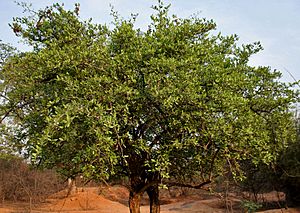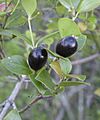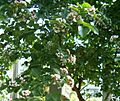Conkerberry facts for kids
Quick facts for kids Conkerberry |
|
|---|---|
 |
|
| Scientific classification | |
| Genus: |
Carissa
|
| Species: |
spinarum
|
| Synonyms | |
|
Numerous, see text |
|
The Carissa spinarum, also known as the Conkerberry or Bush Plum, is a large shrub. It belongs to the dogbane family, called Apocynaceae. You can find this plant in many warm, tropical places. It grows across Africa, Southern Asia, Australia, and various islands in the Indian Ocean.
In Australia, people often call it the currant bush. Sometimes it's also called native currant or black currant. But don't be fooled! It's not actually related to true plums or currants. Those plants are from completely different groups. In India, it's known as wild karanda or wild karavanda. This name comes from its relative, the karanda (C. carandas).
This plant grows as a shrub with many stems. It can be anywhere from 0.5 to 3 meters (about 1.5 to 10 feet) tall. Its leaves are shiny green and grow in pairs. They are narrow and shaped like an egg or a spear, usually 1–5 cm long. The branches have sharp thorns, about 1–3 cm long. The Conkerberry has pretty white, star-shaped flowers, about 1 cm wide. After the flowers, it grows green, egg-shaped berries. These berries are 1–2 cm long and turn black or dark purple when they are fully ripe.
Contents
Where it Lives and Grows (Ecology)
The Conkerberry often grows in areas that are somewhat dry, especially near coasts. It likes fine soils like clay or clay-loams. In very dry places, you might find it at the bottom of hills or in areas that get flooded. This plant is very tough and can live in many different habitats.
In Australia, for example, it often grows near certain types of eucalypt trees. It can be found in coastal rainforests, along rivers, and in thickets. It also grows in open eucalypt savannas, even in places that get less rain.
Edible Fruit and Animals
The Conkerberry fruit is edible, but only when it is fully ripe. Ripe fruits have a sweet taste. However, the milky sap from the plant and its unripe fruit are poisonous. This is common for plants in the dogbane family.
The ripe berries are a popular food for Aboriginal Australians in Central Australia. They call the fruit merne arrankweye in the Arrernte language. It's also called anwekety in Anmatyerr and nganango in Pintupi. Many animals love these fruits too! The Australian bustard, emu, and many other birds eat them. The leaves of the Conkerberry are also food for butterflies, like the Australian crow, and some moths.
Plant Management and Uses
Sometimes, Carissa spinarum can become a problem plant in grazing areas in northern Australia. It can grow so much that it chokes out grasses, making it hard for livestock to eat. It can also get in the way of handling animals and provide hiding places for pests. The plant can spread very quickly by layering (when branches touch the ground and grow roots). It's hard to remove by machine and expensive to control with herbicides.
On the bright side, people have used the Conkerberry to help bring back small birds to disturbed dry rainforests in Queensland, Australia. Parts of the plant are also used medicinally. The Maasai people of Kenya use it to help with joint and muscle pain.
Why it Has Many Names (Synonyms)
The Conkerberry fruit is well-known to local people, and the plant itself looks a bit different depending on where it grows. Because of this, many botanists (scientists who study plants) described it over and over again. They gave it different names each time! For example, one botanist, Robert Brown, described it four times with different names.
But actually, the plant already had a name given by Carl Linnaeus in 1771. He was a famous scientist who created the system for naming plants and animals. Because Linnaeus named it first, all the names given later are considered "junior synonyms." This means they are not the official name. In Myanmar, the plant is known as Burmese: ခံစပ်; MLCTS: hkang sap.
Images for kids






